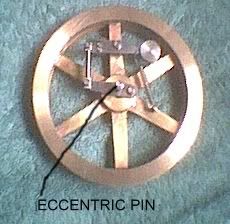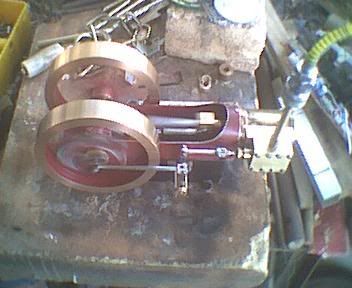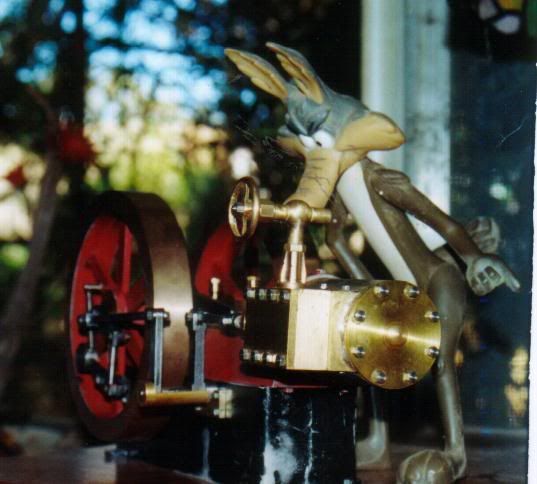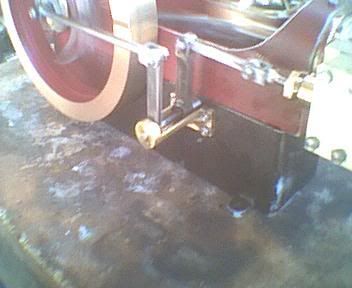Okay, I know---seems like an oxymoron. I have been thinking the last few days of steam engines. I have built 4 steam engines (running them on air) and they all ran well. They also will drain an air tank in fairly short order, because of the high consumption of air. Now---a hit and miss i.c. engine runs on a type of inertial governor, that only lets the engine fire when the RPM's drop below a certain speed. Once it fires, the exhaust valve is held off its tappet untill RPMs fall off again. My idea would never work as a practical engine, but why couldn't one build a steam (air) engine with a pair of large flywheels, and the same type of inertial governor.--The engine would function in normal mode from zero speed and accelerate untill a desired speed was reached. At this speed, the inertial governor would shut off the steam/(air) and the large flywheels would give up their stored energy and keep the engine running untill the engine slowed beyond a critical RPM. When this critical low RPM range was reached, the inertial governor would open the steam/(air) valve again.--Like I said, not a practical engine, but an engine that would run a very long time on a given amount of compressed air.---Has anyone ever done this?
You are using an out of date browser. It may not display this or other websites correctly.
You should upgrade or use an alternative browser.
You should upgrade or use an alternative browser.
Hit and miss STEAM ENGINE????
- Thread starter Brian Rupnow
- Start date

Help Support Home Model Engine Machinist Forum:
This site may earn a commission from merchant affiliate
links, including eBay, Amazon, and others.
- Joined
- Feb 17, 2008
- Messages
- 2,330
- Reaction score
- 445
See what happens when you go away for a few weeks Brian.
Is this sort of what you mean?
http://www.homemodelenginemachinist.com/index.php?topic=3732.0
Gail in NM,USA
Is this sort of what you mean?
http://www.homemodelenginemachinist.com/index.php?topic=3732.0
Gail in NM,USA
Son of a Gun!!! Thats a beauty. I guess I didn't have an original idea after all.---Brian
rickharris
Well-Known Member
- Joined
- Jan 19, 2008
- Messages
- 313
- Reaction score
- 0
Brian Rupnow said:Hit and Miss on steam.---Has anyone ever done this?
John Toms site has plans for a compressed air hit and miss under IC engines http://www.john-tom.com/html/ICEngines.html

$28.51
$45.00
Key Contemporary Buildings: Plans, Sections and Elevations (Key Architecture Series)
Lions Den Books321

$188.98
TM NEXDYNAMI RE41157 Water Pump Compatible With/Replacement For/John Deere 6200 7400 6300 6600 6500 6400 7220 7600 7200 RE41157
VIVID MARKET CORPORATION

$94.99
$109.99
AHS Woodmaster 4400 Maintenance Kit for Outdoor Wood Boiler Treatment
Alternative Heating & Supplies

$99.99
$109.99
AmTech300 - Boiler Treatment Professional Strength (Rust Inhibitor For Outdoor Wood Boilers)
Alternative Heating & Supplies

$45.99
Sunnytech Mini Hot Air Stirling Engine Motor Model Educational Toy Kits Electricity HA001
stirlingtechonline

$403.09
DM14 Engine Build Kit, Metal Engine Build Model Great Metal Material for Engineer for Factory
Easoger Official

$156.90 ($1.40 / oz)
Replacement Combustion Chamber Kit, Burnham V8 and V8H, 1-6 Sec, 108136-01, 1129
Lynn Manufacturing

$59.99
Sunnytech Hot Air Stirling Engine Motor Model Educational Toy Electricity Generator Colorful LED (SC001)
stirlingtechonline

$104.99
Sunnytech Hot Air Stirling Engine Motor Steam Heat Education Model Toy Kit M16-CF
stirlingtechonline

$15.99 ($0.05 / Count)
$18.99 ($0.06 / Count)
HongWay 300pcs 2 Inches Sanding Discs Pad Kit for Drill Sanding Grinder Rotary Tools with Backer Plate Shank and Soft Foam Buffering Pad, Sandpapers Includes 60-3000 Grit
HongWay US

$649.00
$699.00
FoxAlien Masuter Pro CNC Router Machine, Upgraded 3-Axis Engraving All-Metal Milling Machine for Wood Acrylic MDF Nylon Carving Cutting
FoxAlien Official

$190.00
$254.99
Genmitsu CNC 3018-PRO Router Kit GRBL Control 3 Axis Plastic Acrylic PCB PVC Wood Carving Milling Engraving Machine, XYZ Working Area 300x180x45mm
SainSmart Official

$39.99
$49.99
Sunnytech Low Temperature Stirling Engine Motor Steam Heat Education Model Toy Kit For mechanical skills (LT001)
stirlingtechonline
Time on my hands and a curious mind are an evil combination----
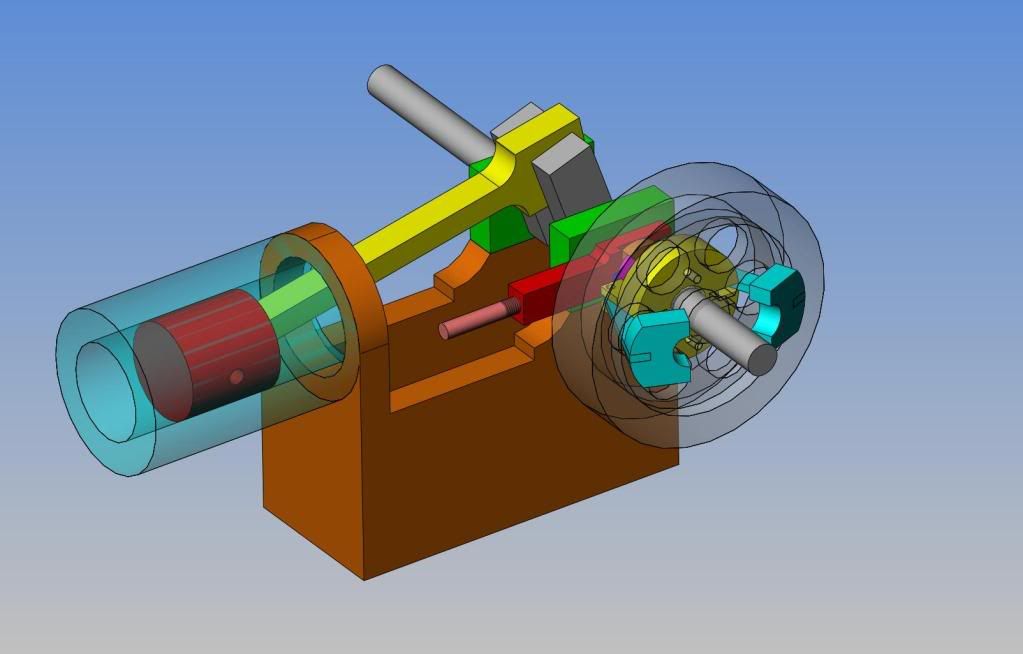
View attachment FULL ASSY HIT AND MISS ENGINE.PDF

View attachment FULL ASSY HIT AND MISS ENGINE.PDF
Well, enough of this foolishness for a Saturday morning!! Not to disparage anyone elses drawings/plans, but there seems to be a lot of either missing dimensions or else downright wrong dimensions on the information I have dug up on this project. Of course, that could just be me. ;D ;D This is a fascinating little engine.--Brian
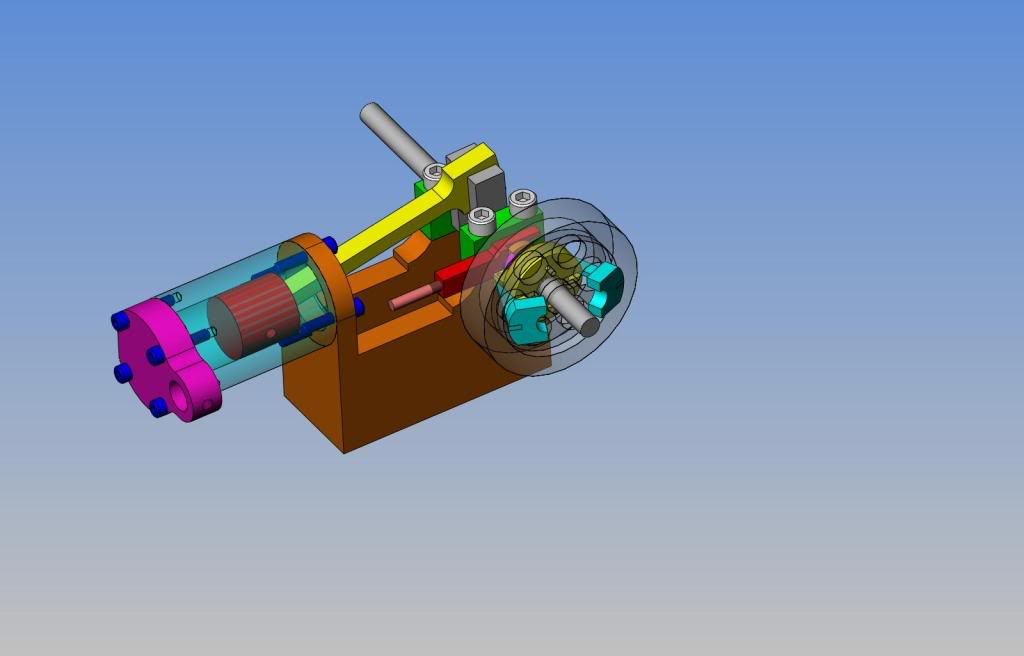

- Joined
- Jan 24, 2009
- Messages
- 554
- Reaction score
- 124
OK, I gotta ask this question:
Doesn't the flyball governor on a steam engine 'sense' speed, like the governor on a hit and miss, and adjust the amount of steam going into the engine? I seems to me like the regular flyball governor does the same thing.
What am I missing here??
Thanks,
Pete
Doesn't the flyball governor on a steam engine 'sense' speed, like the governor on a hit and miss, and adjust the amount of steam going into the engine? I seems to me like the regular flyball governor does the same thing.
What am I missing here??
Thanks,
Pete
tel
Well-Known Member
- Joined
- Feb 8, 2008
- Messages
- 3,293
- Reaction score
- 44
Doesn't the flyball governor on a steam engine 'sense' speed, like the governor on a hit and miss, and adjust the amount of steam going into the engine? I seems to me like the regular flyball governor does the same thing.
Well, yes it does, but it doesn't shut the steam off completely, which is what I think Brian is trying to achieve here. Mind you, the Ames type - shown in my pics - could be slightly modified to achieve the same end.
- Joined
- Jan 24, 2009
- Messages
- 554
- Reaction score
- 124
Ahhhhh, I see. Thanks Tel, ya turned the light on for me! And I think I see where a modification could maybe do the shutoff trick.....maybe. The 'vision' is still fuzzy.
Thanks,
Pete
Thanks,
Pete
10K Pete---To help understand the difference in the two systems---Yes, the flyball type governor does run off engine speed, and it does supply more steam or less steam, depending on the load on the engine and the RPM of the crankshaft. However, the valving on a conventional steam engine is ran independently of the governor, from a mechanical "cam" (eccentric). The valve which lets steam enter or exit the cylinder is going to operate the same regardless of how much or how little steam is entering the cylinder. Because of this, the engine will not "coast" very well.--For example, if the inlet valve was shut off completely, then the piston would have to"pull a vacuum " to go down on the power stroke , which makes for poor coasting. (Kinda like a Jake brake in reverse)
On the hit and miss type of engine, the governor is also speed sensitive, but when hi speed and centrifugal force cause the weights to fly out, the steam inlet valve is rendered inoperative (it stays closed) and the exhaust valve remains open all the time, so that the engine can coast (freewheel) without pulling a vacuum.
On the hit and miss type of engine, the governor is also speed sensitive, but when hi speed and centrifugal force cause the weights to fly out, the steam inlet valve is rendered inoperative (it stays closed) and the exhaust valve remains open all the time, so that the engine can coast (freewheel) without pulling a vacuum.
With all due respect to Chuck Fellows, who I believe is the originator of this unique valving system, there seem to be a lack of complete details on the valves inner workings. I have used the drawings posted in the download section, plus a bit of imagination, and the fact that the smallest taps and dies I care to work with are #5-40 to create 3D models of this valving system.--I am not finished yet, but have made a good start. (I have not shown the spring, clip, and washer that are on the bottom of the valve yet.) When I get this sorted out to my satisfaction, I will post complete details (my interpretation), but as I say, any credit for the original idea goes to Chuck Fellows. EDIT--EDIT--EDIT--In case you didn't notice, I had the port in the side of the valve facing the wrong direction. I have edited the .jpg and the .pdf files so that the port in the side of the valve faces in towards the cylinder and I put a #10-24 set screw thru the side of the cylinder head to keep the valve in place.
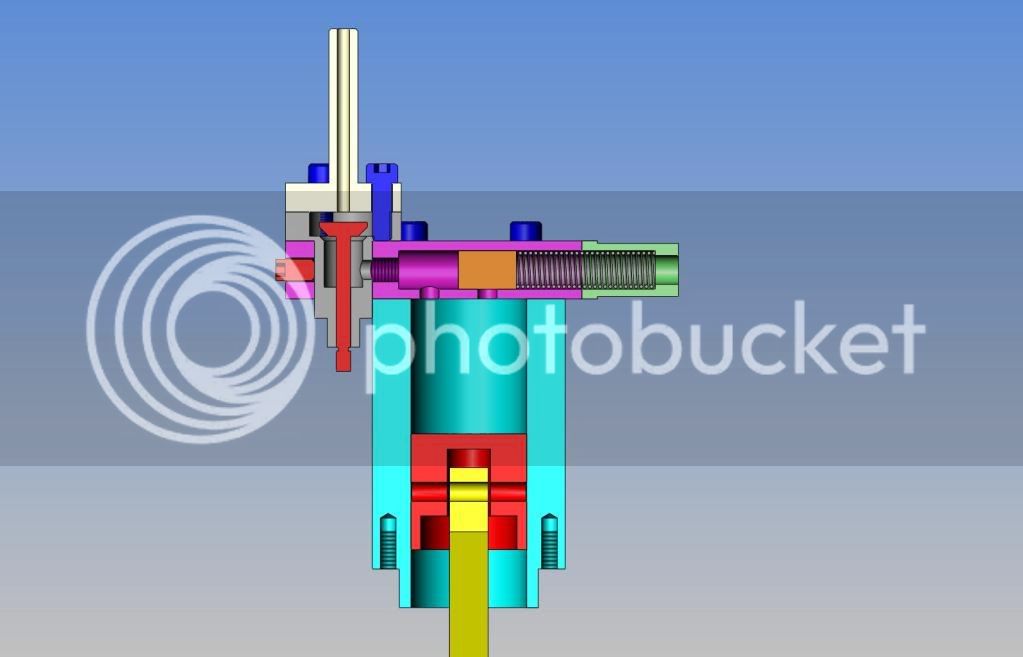
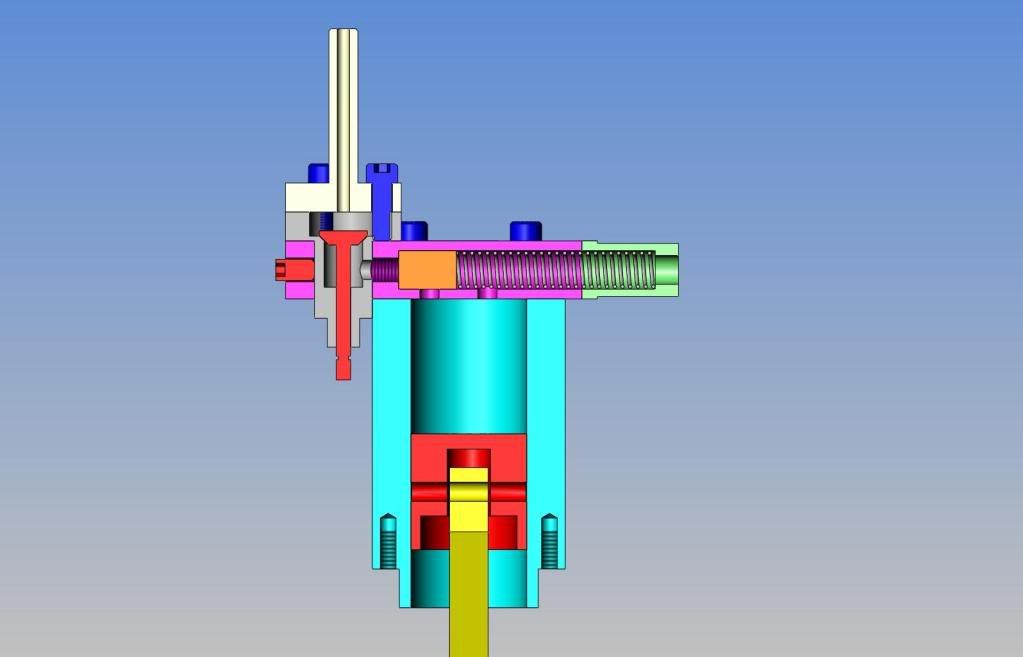
View attachment INLET VALVE CLOSED EXHAUST PORT OPEN.PDF
View attachment INLET VALVE OPEN--EXHAUST CLOSED.PDF


View attachment INLET VALVE CLOSED EXHAUST PORT OPEN.PDF
View attachment INLET VALVE OPEN--EXHAUST CLOSED.PDF
- Joined
- Aug 25, 2007
- Messages
- 3,890
- Reaction score
- 715
Nice drawings, Brian. Wish I had your experience and ability with CAD!
This design is one of my earlier versions. Since then I've simplified the design to use a single hole from the head into the cylinder, instead of two, and to simply use a ball bearing for the slave valve instead of a cylindrical piston.
I only note this, because it's somewhat easier to build.
Chuck
This design is one of my earlier versions. Since then I've simplified the design to use a single hole from the head into the cylinder, instead of two, and to simply use a ball bearing for the slave valve instead of a cylindrical piston.
I only note this, because it's somewhat easier to build.
Chuck
Chuck--are there any plans of this "later version" you speak of?-Where can I see more information about it? I am glad you have chimed in here, I always feel a bit cheesy about posting my interprestation of someone elses design.--Does the later version give the same performance and distinctive "popping" sound?
Yes, Tel---I guess that must be it, although Chuck metions a ball rather than a cylindrical slug as shown. --Do you have the link to whatever thread you got those pic's from please.---Brian
- Joined
- Jan 24, 2009
- Messages
- 554
- Reaction score
- 124
Well I'll be dipped. Any of those are about the slickest valve setup.......
Sure are some clever folks around here! I'm like a fly on the wall just soakin' it up.
Thanks!
Pete
Sure are some clever folks around here! I'm like a fly on the wall just soakin' it up.
Thanks!
Pete
Well, this is what it ends up looking like. I used 3 1/2" diameter flywheels to give as much inertial coasting as I could get, The bore is 3/4" and the stroke is 1.236 (Chuck will know why). I used a 1/4" diameter crankshaft with brass one peice bearing blocks. I kept everything as simple as I could, with a one peice crankcase hogged out of aluminum. I'm still not totally clear on the connection between the valve stem and the push rod which activates it, but that will come.
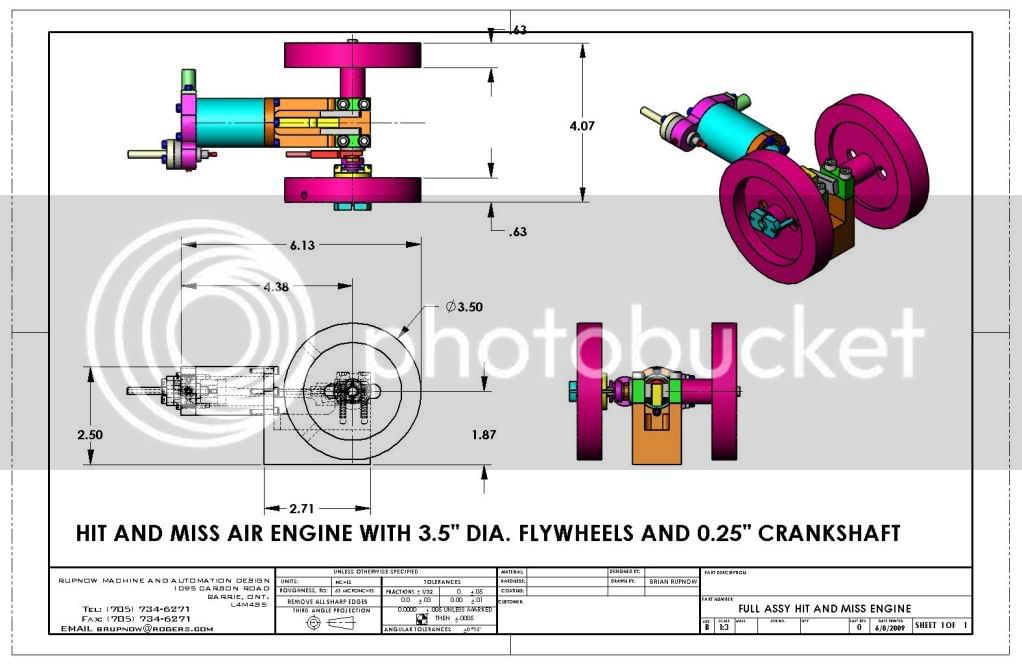
View attachment FULL ASSY HIT AND MISS ENGINE-DRAWING.PDF

View attachment FULL ASSY HIT AND MISS ENGINE-DRAWING.PDF
Similar threads
- Replies
- 0
- Views
- 335
- Replies
- 19
- Views
- 2K
- Replies
- 5
- Views
- 2K




